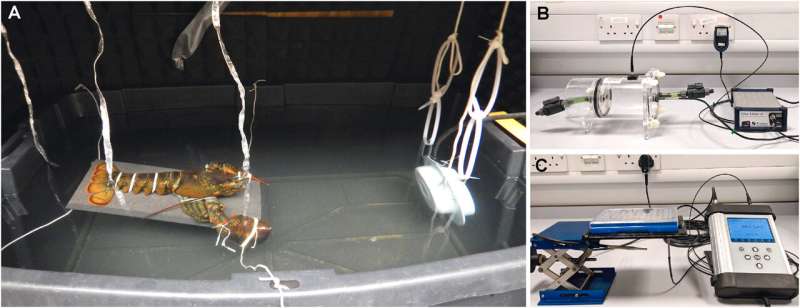This article has been reviewed according to Science X's editorial process and policies. Editors have highlighted the following attributes while ensuring the content's credibility:
fact-checked
peer-reviewed publication
proofread
International scientists warn of the serious impact of noise pollution on marine invertebrates

An international scientific study, led by the UPC's Laboratory of Applied Bioacoustics (LAB), shows that noise from human operations at sea damages marine invertebrates and ocean ecosystems. Published in Frontiers in Marine Science, the work points out that noise pollution at sea can even cause death in some marine species.
In recent decades, scientists have studied the sensitivity to noise of marine mammals—especially cetaceans and pinnipeds—and fish because they are known to possess hearing organs. Recent studies have revealed that a wide variety of invertebrates are also sensitive to sound, particularly via sensory organs whose function is to allow maintaining equilibrium in the water column and to sense gravity. Not only do marine invertebrates represent the largest proportion of marine biomass and are indicators of ocean health, but many species also have important socio-economic values.
A team of scientists, made up of researchers from the Laboratory of Applied Bioacoustics (LAB) from the Universitat Politècnica de Catalunya—BarcelonaTech (UPC) and other universities and research centers in Australia, Spain, the United States, France, Japan, Italy, New Zealand and the United Kingdom, have reviewed hundreds of studies on the impact of noise on marine invertebrates such as crabs, molluscs, squids, prawns and worms. They concluded that anthropogenic noise—noise from human operations—is harming these species in many ways, from cellular to ecosystem level.
"Many people are surprised to discover that invertebrates can even perceive sound, but sound is, in fact, essential to their survival," explains Marta Solé, UPC's LAB researcher linked to the Polytechnic School of Engineering of Vilanova i la Geltrú (EPSEVG). "Light does not travel easily underwater, but sound does, and invertebrates use sound for their vital activities (interspecific communication, predator detection, reproduction, etc.). Human operations, especially shipping, are changing the ocean soundscape very rapidly, and this study brings together the latest evidence on these impacts." Shipping is the main source of marine noise, but there are many others—drilling, dredging, sonar, etc.—and this affects the natural balance of the oceans.
Multiple impacts
Titled "Marine invertebrates and noise," the paper was published in the journal Frontiers in Marine Science. It warns of the multiple impacts of noise pollution on invertebrates, such as delayed hatching and development of eggs, and significantly increased larvae abnormality and mortality rates in crustaceans, bivalves (mussels and oysters), gastropods (snails) and cephalopods (cuttlefish and squids).
Low-frequency sounds, such as those from underwater explosions, can cause injury and even death in blue crabs. Long-term exposure of these species to noise also affects their behavior. Ship noise limits shore crabs' ability to change color for camouflage, according to the team of researchers.
After sound exposure, Mediterranean common cuttlefish showed changes in the protein content, mainly structure- and stress-related proteins. The authors have also reviewed studies demonstrating physiological changes in some species, such as a significant reduction in the rate of growth and reproduction, an increase in the level of aggressiveness and the mortality rate, and a reduction in feed intake.
Recent studies have revealed that a wide range of invertebrates are sensitive to sounds, especially via statocysts—analogous to the vertebrate inner ear—whose original function is to allow maintaining equilibrium in the water column and to sense gravity.
How do invertebrates produce and detect sound?
Sound travels about five times faster in water (ca. 1,500 m/s) than in air (ca. 340 m/s) because the density of water is greater, and also attenuates less over the same distance. Invertebrates detect underwater sound through three types of sensory systems: ciliated receptors on the body surface, statocysts and chordotonal organs, linked to the joints of antennae or legs in crustaceans.
They can also produce sounds: from "coughing" in scallops to stridulation, in which lobsters, crayfish, prawns and crabs rub together certain body parts—similar to bowing a violin—and make sounds that may scare off predators. The study presents all these forms of sound production and perception specific to invertebrates, and the techniques used for their analysis.
Effects of noise on ecosystems
By changing the behavior and health of predators and prey in complex food webs, noise can thus affect entire ecosystems. Invertebrates provide major ecosystem functions, such as water filtering, habitat creation, organic matter processing, carbon transfer through food webs and nutrient recycling. Therefore, researchers see it as urgent to continue research in this area to mitigate the impacts.
"Our study highlights that these animals exist in a rich underwater soundscape," explains Dr. Sophie Nedelec from the University of Exeter. "We need to learn more about the impacts of noise pollution on these animals and ecosystems. Given that noise can affect invertebrates from cellular to ecosystem level, we need to bring together interdisciplinary expertise to gain a holistic view of the problem. Considering the many anthropogenic pressures, including climate change and fishing, we must do everything possible to limit underwater noise."
The study summarizes the current scientific knowledge on invertebrate bioacoustics (sound production, reception, sensitivity) and on how marine invertebrates are affected by anthropogenic noises. It also identifies gaps in scientific knowledge on the noise tolerance of marine ecosystems, concluding that more research is needed.
More information: Marta Solé et al, Marine invertebrates and noise, Frontiers in Marine Science (2023). DOI: 10.3389/fmars.2023.1129057
Journal information: Frontiers in Marine Science
Provided by Universitat Politècnica de Catalunya




















